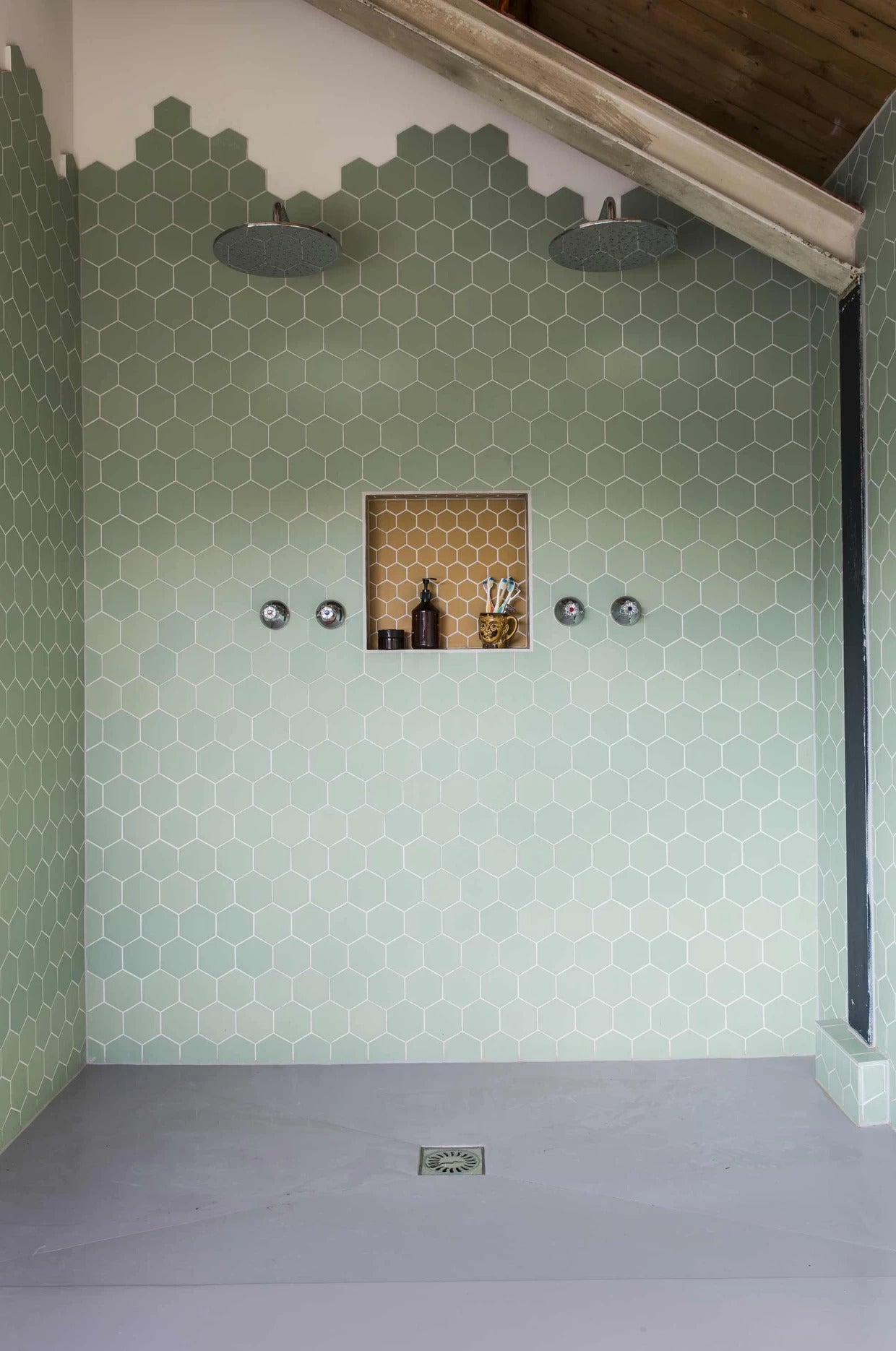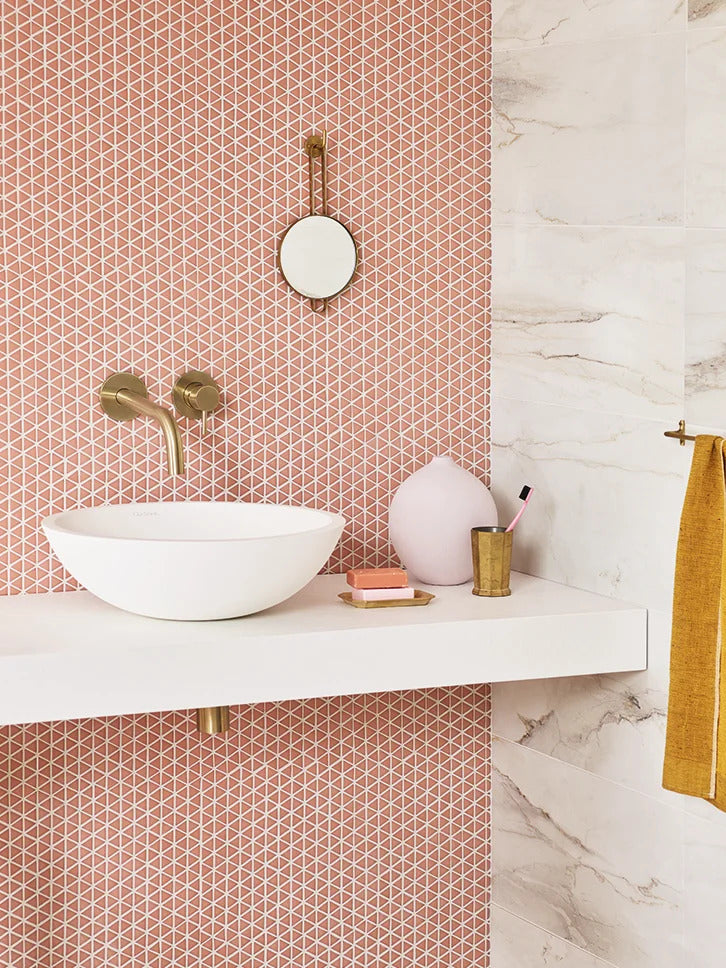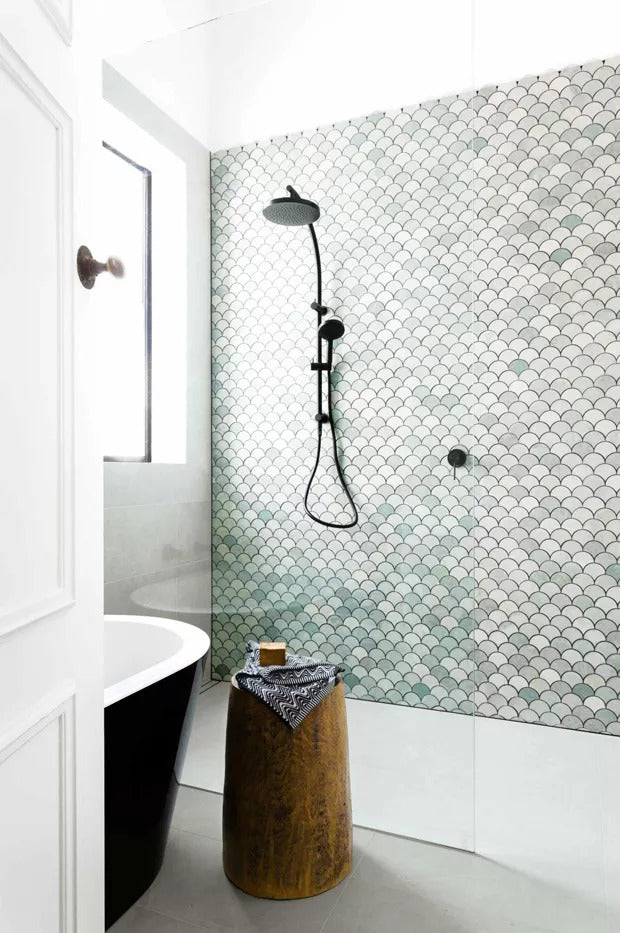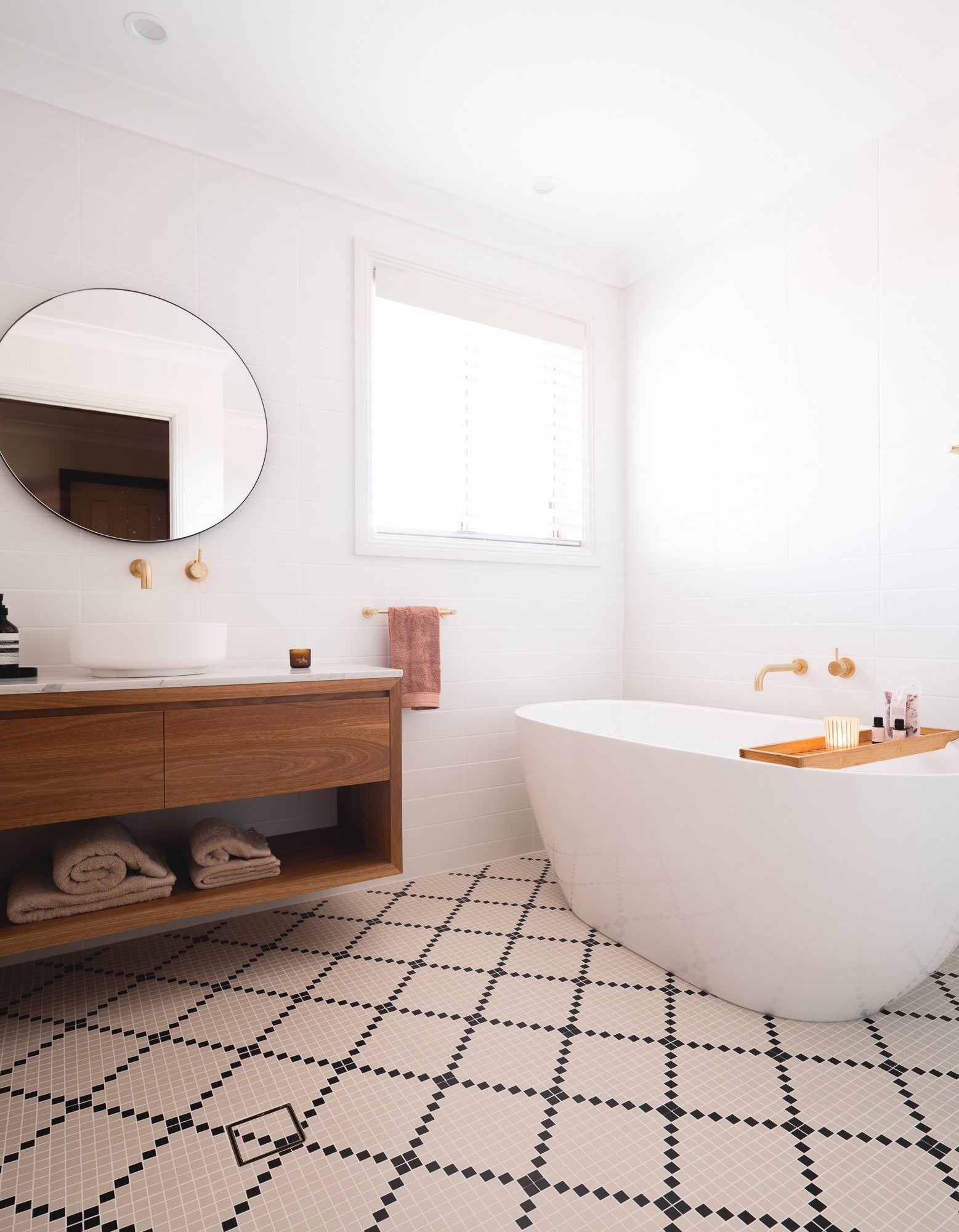Table Of Contents:
- Different ways you can use mosaic tiles in a bathroom
- An overview of the finishes of mosaic bathroom tiles
- Key installation considerations
- Grout application tips
What are the different ways you can use mosaic tiles in a bathroom?
Mosaic tiles are a versatile and stylish way to add color, texture, and interest to a bathroom. Here's an overview of the different ways you can use mosaic tiles in a bathroom:
- Shower or bathtub surround: Adding a mosaic tile border or accent to your shower or bathtub surround can add a pop of color and texture to your bathroom. Mosaic tiles are durable and resistant to moisture, making them an excellent choice for areas that will be exposed to water.
 Image source: Pinterest
Image source: Pinterest- Backsplash: A mosaic tile backsplash can add a decorative touch to your bathroom sink area while also protecting the wall from water damage. Mosaic tiles come in a variety of patterns, colors, and finishes, allowing you to create a unique and stylish look.
 Image source: Pinterest
Image source: Pinterest- Flooring: Mosaic tiles can be used as bathroom flooring, providing a durable and slip-resistant surface. They are available in a variety of colors, shapes, and sizes, allowing you to create a custom look that complements the rest of your bathroom design.
 Product featured: Ritz 20 White With Black Pattern
Product featured: Ritz 20 White With Black Pattern- Accent wall: A mosaic tile accent wall can add a focal point to your bathroom, creating a stylish and eye-catching feature. Mosaic tiles can be arranged in a variety of patterns and designs, from simple stripes to intricate geometric shapes.
 Image source: Pinterest
Image source: Pinterest- Border or trim: Mosaic tiles can be used as a border or trim around bathroom mirrors, windows, or doorways, adding a decorative touch to these areas. They can also be used to frame artwork or other decorative elements in your bathroom.
What are the different finishes of bathroom mosaic tiles?
Bathroom mosaic tiles can add an attractive and stylish touch to any bathroom. Mosaics are available in a range of finishes, each with its unique features and benefits. Here's an overview of the different finishes of bathroom mosaics:
- Ceramic: Ceramic mosaic tiles are the most commonly used bathroom mosaics due to their versatility, durability, and affordability. They are resistant to water, stains, and scratches, making them ideal for bathroom use. Ceramic mosaics are available in a wide range of colors, shapes, and sizes.
- Glass: Glass mosaic tiles are another popular option for bathroom mosaics due to their translucence and ability to reflect light, adding a bright and reflective effect to the bathroom. Glass mosaics come in a variety of colors, shapes, and sizes and can be used as accent pieces or to create entire bathroom walls or backsplashes.
- Stone: Stone mosaic tiles, such as marble, granite, and travertine, offer a natural and elegant look to any bathroom. Stone mosaics are durable, easy to maintain, and resistant to moisture, making them an excellent choice for bathroom use. They come in a variety of colors, patterns, and finishes, from polished to honed or brushed.
- Metal: Metal mosaics tiles, such as stainless steel, copper, or aluminum, can add a modern and sleek look to any bathroom. They are durable, easy to maintain, and resistant to moisture and stains. Metal mosaics come in a variety of finishes, such as polished, brushed, or matte.
- Porcelain: Porcelain mosaic tiles are a durable and long-lasting option for bathroom use. They are resistant to moisture, stains, and scratches, making them the most ideal finish for bathroom floors. Porcelain mosaics come in a range of colors, patterns, and finishes, from matte to polished.
What are the key considerations when installing mosaic bathroom tiles?
Installing mosaic bathroom tiles can be a great way to add style and character to your bathroom, but it is important to consider several factors to ensure a successful and long-lasting installation. Here are some key considerations when installing mosaic bathroom tiles:
- Surface preparation: The surface that you plan to install the mosaic tiles on should be clean, flat, and dry. If the surface is not level, you may need to use a leveling compound to create a smooth and even base.
- Tile layout: Mosaic tiles are available in a variety of shapes, sizes, and colors, and you can create a range of patterns and designs with them. Before starting the installation, plan out the layout of the tiles, taking into account the size of the tiles, the size of the space, and any fixtures or obstacles in the way.
- Adhesive selection: Choosing the right adhesive for your mosaic tiles is important for a successful installation. The adhesive should be strong enough to hold the tiles in place but also flexible enough to allow for any movement in the substrate. Consider the type of substrate you are tiling onto, the size and weight of the tiles, and the environmental conditions in the bathroom when selecting your adhesive.
- Cutting and shaping tiles: Mosaic tiles can be cut and shaped to fit around obstacles, such as pipes or corners. Use a tile cutter or wet saw to make precise cuts, and use a file or sandpaper to smooth any rough edges.
- Grouting: Grouting is an essential part of the installation process, as it fills in the gaps between the tiles and helps to hold them in place. Select the appropriate grout for your tiles, and apply it carefully and evenly, making sure to fill all the gaps. Clean any excess grout off the surface of the tiles before it dries.
- Sealing: Sealing the tiles and grout is important to protect them from moisture, stains, and mildew. Use a sealer appropriate for your type of tile and grout, and follow the manufacturer's instructions for application.
What grout application tips do you have for installing mosaic tiles?
Grouting mosaic bathroom tiles can be a challenging task, but with the right tools and techniques, it can be done efficiently and effectively. Here are some tips for applying grout to your mosaic bathroom tiles:
- Choose the right type of grout: There are several types of grout available, including sanded and unsanded grout. Sanded grout is best for mosaic tiles that have larger spaces between them, while unsanded grout is best for smaller spaces. Also, choose a grout that is appropriate for the bathroom environment, as some types of grout may not be resistant to moisture or mildew.
- Prepare the surface: Before applying grout, make sure the surface is clean and dry. Wipe down the tiles with a damp cloth and allow them to dry completely before starting the grouting process.
- Mix the grout: Follow the manufacturer's instructions to mix the grout to the right consistency. You may need to adjust the amount of water or grout powder to achieve the desired consistency.
- Apply the grout: Using a grout float, apply the grout to the mosaic tiles, making sure to fill in all the gaps between the tiles. Work in small sections, starting at the top of the wall and working your way down. Make sure to apply the grout at a 45-degree angle to ensure it gets into the gaps.
- Clean the excess grout: Once you have applied the grout, use a damp sponge to clean the excess grout off the tiles. Be careful not to remove too much grout from the gaps between the tiles.
- Allow the grout to dry: Allow the grout to dry according to the manufacturer's instructions. This may take several hours or even a day or two, depending on the type of grout you use.
- Seal the grout: Once the grout is completely dry, apply a grout sealer to protect the grout from moisture and mildew.
In conclusion, mosaic bathroom tiles are a versatile and popular choice for any bathroom design. With their ability to create unique patterns, textures, and colors, they can add visual interest and dimension to any space. Additionally, the durability and easy maintenance of mosaic tiles make them a practical choice for bathroom flooring and walls. Whether you opt for glass, ceramic, or natural stone mosaic tiles, the options are endless. With proper installation and care, mosaic bathroom tiles can provide a timeless and elegant look for years to come.
Explore our collection of porcelain mosaic patterns
Create a stunning and practical space with Olde English Tiles' collection of porcelain mosaic tiles. With over 32 colours to choose from, our french made mosaics are perfect for your bathroom, kitchen, front entrance, and beyond.
Popular mosaic patterns for a bathroom:
View full collection of porcelain mosaic tiles




